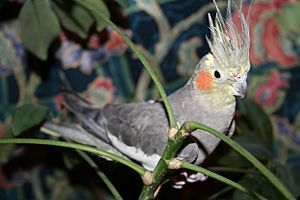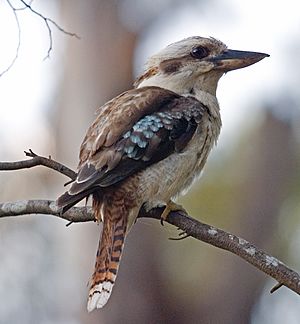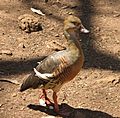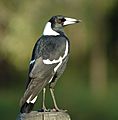Birds of Australia facts for kids
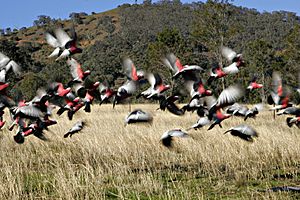
Australia and its offshore islands and territories have 898 recorded bird species as of 2014. Of the recorded birds, 165 are considered vagrant or accidental visitors, of the remainder over 45% are classified as Australian endemics: found nowhere else on earth. It has been suggested that up to 10% of Australian bird species may go extinct by the year 2100 as a result of climate change.
Australian species range from the tiny 8 cm (3.1 in) weebill to the huge, flightless emu. Many species of Australian birds will immediately seem familiar to visitors from the Northern Hemisphere: Australian wrens look and act much like northern wrens, and Australian robins seem to be close relatives of the northern robins. However, the majority of Australian passerines are descended from the ancestors of the crow family, and the close resemblance is misleading: the cause is not genetic relatedness but convergent evolution.
For example, almost any land habitat offers a nice home for a small bird that specialises in finding small insects: the form best fitted to that task is one with long legs for agility and obstacle clearance, moderately-sized wings optimised for quick, short flights, and a large, upright tail for rapid changes of direction. In consequence, the unrelated birds that fill that role in the Americas and in Australia look and act as though they are close relatives.
Australian birds which show convergent evolution with Northern Hemisphere species:
- honeyeaters (resemble sunbirds)
- sittellas (resemble nuthatches)
- Australasian babblers (resemble scimitar babblers)
- Australian robins (resemble Old World chats)
- Scrub robins (resemble thrushes)
Kinds of birds
Australian birds can be classified into six categories:
- Old endemics: long-established non-passerines of ultimately Gondwanan origin, notably emus, cassowaries and the huge parrot group
- Corvid radiation: Passerines peculiar to Australasia, descended from the crow family, and now occupying a vast range of roles and sizes; examples include wrens, robins, magpies, thornbills, pardalotes, the huge honeyeater family, treecreepers, lyrebirds, birds-of-paradise and bowerbirds
- Eurasian colonists: later colonists from Eurasia, including plovers, swallows, larks, thrushes, cisticolas, sunbirds and some raptors
- Recent introductions: birds recently introduced by humans; some, such as the European goldfinch and greenfinch, appear to coexist with native fauna; others, such as the common starling, blackbird, house and tree sparrows, and the common myna, are more destructive
- Migratory shorebirds: a suite of waders in the Scolopacidae and Charadriidae families which breed in northern Asia and Alaska and spend the non-breeding season in Australasia
- Seabirds: a large and cosmopolitan group of petrels, albatrosses, sulids, gulls, terns and cormorants, many of which either breed on islands within Australian territory or frequent its coast and territorial waters
Regional lists
For comprehensive regional lists, see:
- List of birds of Australia, covering Australia and its territories
- List of birds of Australia, New Zealand and Antarctica, the HANZAB list for Australia, New Zealand, Antarctica and the surrounding ocean and subantarctic islands.
For Australia's endemic species, see:
Other regional, state and island bird lists:
- Victoria
- New South Wales & Lord Howe Island
- Queensland
- Western Australia
- Tasmania
- Northern Territory
- South Australia
- Ashmore Reef
- Boigu, Saibai and Dauan Islands
- Christmas Island
- Cocos (Keeling) Islands
- Heard Island
- Kangaroo Island
- Macquarie Island
- Houtman Abrolhos
Organizations
National organizations
- BirdLife Australia (previously known as Birds Australia) is the leading Australian NGO for birds, birding, ornithology and conservation, formed by a merger of the Royal Australasian Ornithologists Union and Bird Observation & Conservation Australia
- Australian Bird Study Association, for banders and other field ornithologists
- Birding-Aus - an Internet mailing list about Australian birds
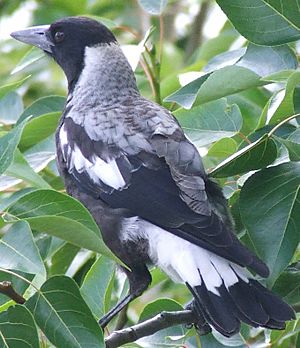
Australian regional and state organisations
- Australian Capital Territory
- Birds Australia Southern NSW & ACT
- Canberra Ornithologists Group
- New South Wales
- NSW Bird Atlassers Inc.
- Birding NSW
- Birds Australia Northern NSW
- Birds Australia Southern NSW & ACT
- Cumberland Bird Observers Club
- Blue Mountains Bird Observers Inc.
- Queensland
- Birds Australia Capricornia
- Birds Australia North Queensland
- Birds Australia Southern Queensland
- Birds Queensland
- South Australia
- Birds SA
- Tasmania
- Birds Tasmania
- Victoria
- Birds Australia - Victoria
- Western Australia
Parasites
The country does not suffer from several Apicomplexan parasites found throughout the rest of the world. Several species of both avian haemoproteids and avian Plasmodium spp. are absent here.
Gallery


